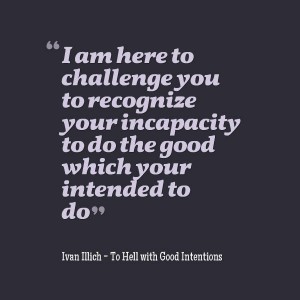It is important to ask how our ideas about “helping” manifest themselves, because these deeper motivations show up in our work. If you grew up as white and in the U.S. as I did, most often people start from a place of charity. There was a lot of “othering” in the environment where I grew up. A phrase commonly used, “over there” [in reference to any other country], indicates how they see people and places that are not related to their own life.
Upholding people’s dignity and wholeness in my work in the aid and philanthropy sectors has been a journey for me, and one that I am still on. The question is: How do we help people move faster on that journey, so that they’re not making the same mistakes over and over?

Let’s just accept that do-gooders are going to start with some really crazy notions in their heads that those of us who have been doing global development and solidarity work for a long time do not want to perpetuate. What are right set of questions to ask them? How do they have the experiences that move them quicker than we did?
We tend to rail against white saviors and voluntourism (for years now – see this must-read speech to the Conference on InterAmerican Student Projects in 1968 by Monsignor Ivan Illich: To Hell With Good Intentions), but just like other kinds of international aid and philanthropy, programs can be done well and can be done poorly.
How do we help more people connect to the structural issues – why poverty occurs, and what is their own role? Once people decide to be outward facing, concerned about the suffering in the world and wanting to express their sense of responsibility to others, how can we invite and support them to transform themselves?
U.S. citizens may be particularly guilty of looking for simple solutions and to saviors, perhaps because of the youthfulness of our nation or because we are attracted to a mystified or romanticized idea of “helping” to develop our own self-worth. But if do-gooders are open in their experience, then something can happen – that aha moment where you see social change work is complex, and it can never be simple again.
Today there are more and more ways that allow people to get money directly to people and projects on the ground. But moving money is not quite as sexy as feeding children on mission trips, is it? That’s the dilemma.
Social and systemic injustice has deep roots. Thus “solutions” don’t magically appear with the introduction of a new person, idea, or resources, and they certainly don’t happen overnight.
The questions for every do-gooder, philanthropist, social entrepreneur, aid worker, impact investor – new or old – to consider are these: What does active solidarity with visionary grassroots leaders in the Global South look like, and how do we create a deeper dialogue with each other? How can I offer the kinds of support to the local leaders and global movements that will transform our society?
***
Related Posts
“Create” nothing, a new social good mantra
Actually, it was my capacity that needed to be built
What advice would you give to new global development students?
Brainwashed by the Do-Gooder Industrial Complex
When the protagonist isn’t a white kid

Pingback: Moving along on the do-gooder journey - Global Health Hub: news and blogosphere aggregator